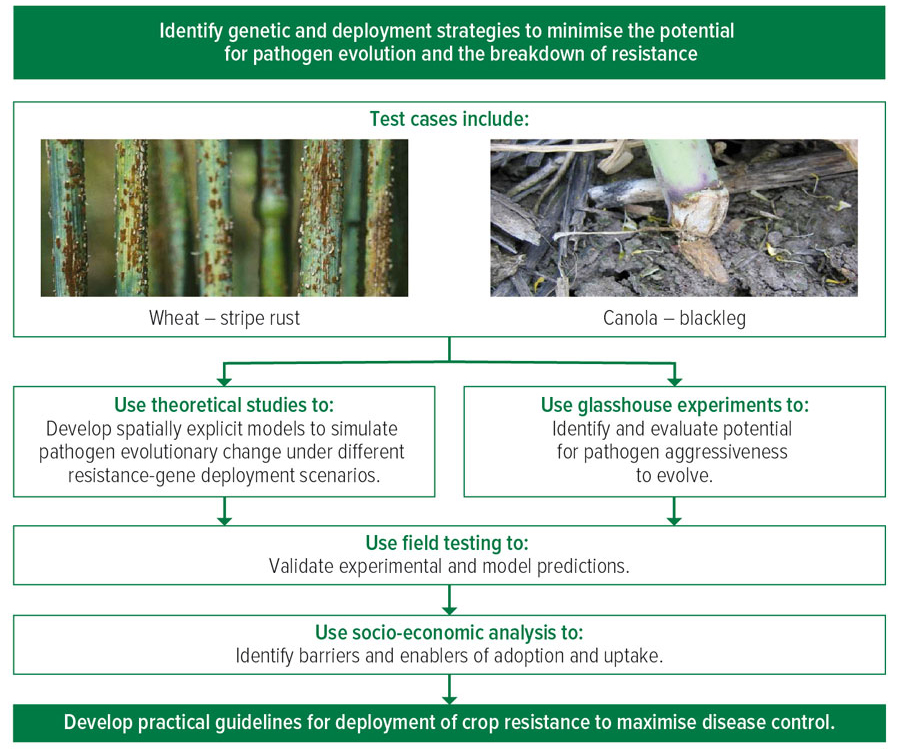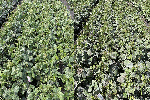Key points
- The durability of valuable disease resistance in crop varieties can be improved by better understanding of how breeding and management strategies influence the potential for pathogens to develop resistance
- Models that simulate pathogen evolution are being used to test different resistance deployment options and identify opportunities to increase the longevity of resistance
Modelling tools reveal opportunities to prolong the effectiveness of disease resistance genes.
Disease-resistant varieties are highly effective at reducing crop losses and help to minimise pesticide use. But their effectiveness can often be short-lived due to pathogen evolution.
For each disease there is only a limited supply of resistance genes and they can be difficult and expensive to identify and deploy into new varieties. When the pathogen evolves resistance to a gene it could be lost forever, resulting in an ongoing need for investment in plant breeding and alternative control options.
Predictive capacity
Finding a way to prolong the effectiveness of these precious resources could save millions, but there are few strategies or recommendations available.
Previous research has shown that the way in which varieties are deployed across landscapes in space and time – for instance using mixtures, mosaics or rotations – influences both the likelihood of disease outbreaks and the potential for pathogens to evolve.
While breeders and growers can choose how varieties are developed and deployed, we still lack the ability to predict which deployment strategy is likely to be best for a given crop-pathogen combination.
With GRDC investment, researchers at CSIRO Agriculture and Food have developed models to understand how to limit unwanted evolution in plant pathogens.
The goal is to provide breeders and growers with scientifically based guidelines for deploying resistant crop varieties based on knowledge of which factors influence the severity of disease outbreaks and the rate at which pathogens can evolve to overcome new resistances. While focused on stripe rust in wheat and blackleg in canola, the basic principles will apply more broadly.
The models simulate pathogen evolution and epidemiology in response to different resistance deployment options, with the results ground-truthed in glasshouse and field experiments (Figure 1).
Figure 1: By combining modelling with glasshouse and field experiments, CSIRO is working to identify opportunities to increase the life span of disease resistance genes in the Australian grains industry.

Source: Dr Peter Thrall
Opportunities
By comparing the rate at which pathogens evolve and the severity of disease outbreaks, the team has identified feasible options to improve the durability of resistant crop varieties in the field. Strategies cover both the way resistance genes are deployed in variety development and how growers use these varieties on-farm.
Relying on genetic solutions alone is risky. While pyramids of multiple major resistance genes can be highly durable and efficient in managing rust pathogens of cereal crops, the consequences of resistance breakdown can be severe. Alternative strategies – especially crop rotations – may better mitigate epidemic losses in the event of breakdown of some or all resistances, particularly when the resistance genes have been previously exposed to pathogens.
Overall, the modelling supports the idea that landscape organisation of varieties can influence our ability to manage crop disease. The optimal strategy will depend on rates of disease spread and evolutionary potential. For example, while field experiments have shown blackleg can spread rapidly in canola, models suggest rotating different resistance genes could make the genes a renewable resource for this system.
More information: Dr Peter Thrall, 0417 992 838, peter.thrall@csiro.au

























































